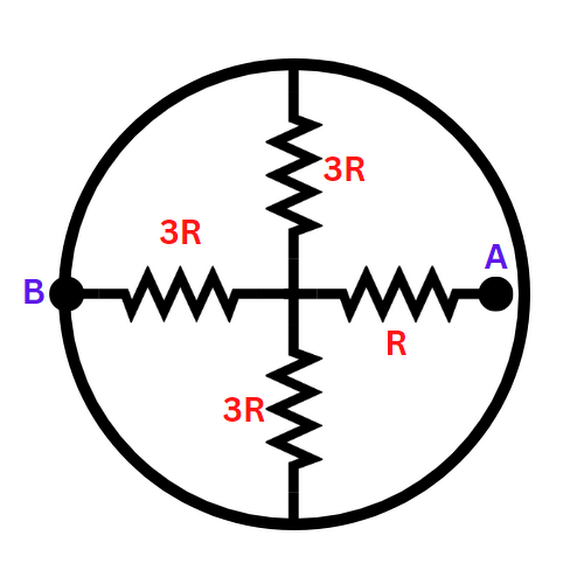
In the network shown below, the ring has zero resistance. The equivalent resistance between the point A and B is

A) 2R
B) 4R
C) 7R
D) 10R
Answer
218.7k+ views
Hint:The problem is from the electricity part of physics. We can apply the concept of parallel combination and series combination of resistance here. Use the equation for effective resistance in parallel and series combinations.
Formula Used:
Equivalent resistance for a series resistance circuit:
${R_E} = {R_1} + {R_2} + {R_3}$
Where ${R_E}$= equivalent resistance and ${R_1},{R_2},{R_3}$ = component resistance.
Equivalent resistance for a parallel resistance circuit:
$\dfrac{1}{{{R_E}}} = \dfrac{1}{{{R_1}}} + \dfrac{1}{{{R_2}}} + \dfrac{1}{{{R_3}}}$
Where ${R_E}$= equivalent resistance and ${R_1},{R_2},{R_3}$ = component resistance.
Complete answer:
The equivalent resistance is a single resistance which can replace all the component resistances in a circuit in such a manner that the current in the circuit remains unchanged.
Equivalent resistance for a series resistance circuit:
${R_E} = {R_1} + {R_2} + {R_3}$
Where ${R_E}$= equivalent resistance and ${R_1},{R_2},{R_3}$ = component resistance.
Equivalent resistance for a parallel resistance circuit:
$\dfrac{1}{{{R_E}}} = \dfrac{1}{{{R_1}}} + \dfrac{1}{{{R_2}}} + \dfrac{1}{{{R_3}}}$
Where ${R_E}$= equivalent resistance and ${R_1},{R_2},{R_3}$ = component resistance.
Here, in this case, the ring has zero resistance and the three $3R$resistances are in parallel connection. So the equivalent resistance will be.
$\dfrac{1}{{{R_E}}} = \dfrac{1}{{3R}} + \dfrac{1}{{3R}} + \dfrac{1}{{3R}} = \dfrac{1}{R}$
\[{R_E} = R\]
Then between points A and B, the two resistances \[{R_E}\]and \[R\]are in series combination.
Then equivalent resistance between A and B = \[R + R = 2R\]
Hence, the correct option is Option (A) 2R.
Additional Information:
Resistance is a measure of the opposition to current flow in an electrical circuit. Resistance blocks the flow of current. The S.I unit of resistance is ohms. The current decreases as resistance increases. On the other hand, the current increases as the resistance decreases.
When electrons move through a conductor, like a metal wire, an electric current occurs. The ions in the metal can collide with the travelling electrons. Resistance is created as a result and makes it more difficult for the current to flow.
Note: A device created to produce resistance is called a resistor. Resistors can be used to divide voltage, limit current, or produce heat. Fixed and variable resistors are the two main types of resistors. In other words, a resistor is a passive two-terminal electrical component used in circuits to implement electrical resistance.
Formula Used:
Equivalent resistance for a series resistance circuit:
${R_E} = {R_1} + {R_2} + {R_3}$
Where ${R_E}$= equivalent resistance and ${R_1},{R_2},{R_3}$ = component resistance.
Equivalent resistance for a parallel resistance circuit:
$\dfrac{1}{{{R_E}}} = \dfrac{1}{{{R_1}}} + \dfrac{1}{{{R_2}}} + \dfrac{1}{{{R_3}}}$
Where ${R_E}$= equivalent resistance and ${R_1},{R_2},{R_3}$ = component resistance.
Complete answer:
The equivalent resistance is a single resistance which can replace all the component resistances in a circuit in such a manner that the current in the circuit remains unchanged.
Equivalent resistance for a series resistance circuit:
${R_E} = {R_1} + {R_2} + {R_3}$
Where ${R_E}$= equivalent resistance and ${R_1},{R_2},{R_3}$ = component resistance.
Equivalent resistance for a parallel resistance circuit:
$\dfrac{1}{{{R_E}}} = \dfrac{1}{{{R_1}}} + \dfrac{1}{{{R_2}}} + \dfrac{1}{{{R_3}}}$
Where ${R_E}$= equivalent resistance and ${R_1},{R_2},{R_3}$ = component resistance.
Here, in this case, the ring has zero resistance and the three $3R$resistances are in parallel connection. So the equivalent resistance will be.
$\dfrac{1}{{{R_E}}} = \dfrac{1}{{3R}} + \dfrac{1}{{3R}} + \dfrac{1}{{3R}} = \dfrac{1}{R}$
\[{R_E} = R\]
Then between points A and B, the two resistances \[{R_E}\]and \[R\]are in series combination.
Then equivalent resistance between A and B = \[R + R = 2R\]
Hence, the correct option is Option (A) 2R.
Additional Information:
Resistance is a measure of the opposition to current flow in an electrical circuit. Resistance blocks the flow of current. The S.I unit of resistance is ohms. The current decreases as resistance increases. On the other hand, the current increases as the resistance decreases.
When electrons move through a conductor, like a metal wire, an electric current occurs. The ions in the metal can collide with the travelling electrons. Resistance is created as a result and makes it more difficult for the current to flow.
Note: A device created to produce resistance is called a resistor. Resistors can be used to divide voltage, limit current, or produce heat. Fixed and variable resistors are the two main types of resistors. In other words, a resistor is a passive two-terminal electrical component used in circuits to implement electrical resistance.
Recently Updated Pages
A square frame of side 10 cm and a long straight wire class 12 physics JEE_Main

The work done in slowly moving an electron of charge class 12 physics JEE_Main

Two identical charged spheres suspended from a common class 12 physics JEE_Main

According to Bohrs theory the timeaveraged magnetic class 12 physics JEE_Main

ill in the blanks Pure tungsten has A Low resistivity class 12 physics JEE_Main

The value of the resistor RS needed in the DC voltage class 12 physics JEE_Main

Trending doubts
JEE Main 2026: Application Form Open, Exam Dates, Syllabus, Eligibility & Question Papers

Derivation of Equation of Trajectory Explained for Students

Hybridisation in Chemistry – Concept, Types & Applications

Understanding the Angle of Deviation in a Prism

Understanding Collisions: Types and Examples for Students

Understanding Atomic Structure for Beginners

Other Pages
JEE Advanced Marks vs Ranks 2025: Understanding Category-wise Qualifying Marks and Previous Year Cut-offs

How to Convert a Galvanometer into an Ammeter or Voltmeter

Understanding Centrifugal Force in Physics

JEE Main Marking Scheme 2026- Paper-Wise Marks Distribution and Negative Marking Details

Degree of Dissociation: Meaning, Formula, Calculation & Uses

Understanding Electromagnetic Waves and Their Importance




